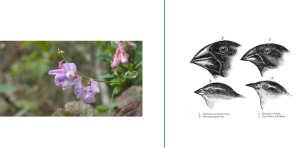15.1 Introduction to Classical, Population, and Evolutionary Genetics
Elizabeth Dahlhoff

In the following two sections of the text (Chapters 15 and 16), we will investigate classical, population and evolutionary genetics. A good start to thinking about genetics is to consider the work of two scientists- Gregor Mendel and Charles Darwin. Johann Gregor Mendel set the framework for genetics long before chromosomes or genes had been identified, at a time when key details of sexual reproduction (meiosis and fertilization) were not well understood. Mendel selected a simple biological system (garden peas) and conducted methodical, quantitative analyses using large sample sizes. Because of Mendel’s work, the fundamental principles of heredity were revealed. In contrast, Charles Darwin’s theory of evolution by natural selection focused on how different species on earth change over time, with new species arising from pre-existing ones through a process of gradual modification. Darwin suggested that three things were needed for evolution by natural selection to occur in a population: variation, inheritance, and differential survival of offspring; the process favors individuals with traits that enhance their survival and reproduction in a given environment, leading to the accumulation of favorable characteristics in populations over generations.
While Charles Darwin and Gregor Mendel never met or corresponded directly, their work is now seen as deeply intertwined in our understanding of both genetics and evolution. The postulates put forth by Mendel form the basis of classical genetics. We now know that genes, carried on chromosomes, are the basic functional units of heredity with the capability to be replicated, expressed, or mutated. Not all genes are transmitted from parents to offspring according to Mendelian genetics, but Mendel’s experiments serve as an excellent starting point for thinking about inheritance. Darwin’s theory of evolution by natural selection is a central conceptual tenet of modern biology, but the theory as originally posited needed a mechanism for inheritance- genetics provides that mechanism. Though Mendel’s findings were published during Darwin’s lifetime, Darwin likely never encountered them, and it wasn’t until the mid 20th century that their work was synthesized into the field of population genetics, which combines Darwin’s theory of evolution by natural selection with Mendel’s principles of genetics, creating a more complete understanding of both genetics and evolution.
Here (Video 15.1.1) is a Crash Course version of an imaginary meeting between Mendel and Darwin (yay finger puppets!).
Video 15.1.1. Population Genetics: When Darwin Met Mendel – Crash Course Biology #18 by CrashCourse
Figure Descriptions
Figure 15.1.1. Split image. Left panel shows a close-up photo of a cluster of pink and purple pea flowers with green foliage in the background. Right panel shows four black-and-white sketches of Galapagos finch heads, each with different beak shapes. Labels: “1. Geospiza magnirostris,” “2. Geospiza fortis,” “3. Geospiza parvula,” and “4. Certhidea olivacea.” [Return to Figure 15.1.1]
Licenses and Attributions
Media Attributions
- garden peas and Darwin’s finches by Gould
